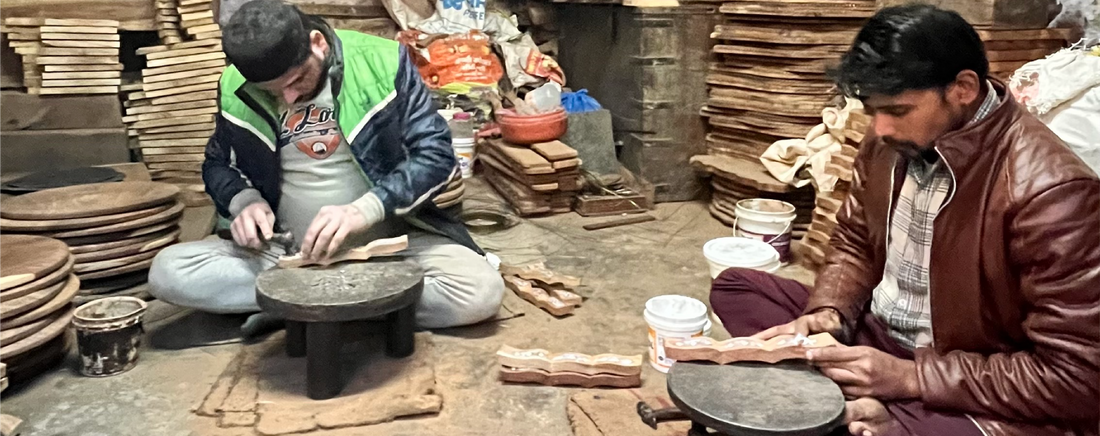Wood carving, an ancient artisanal practice, has found its zenith in the historical town of Saharanpur, India. This craft, deeply embedded in the cultural tapestry of the region, narrates a compelling story of skill, tradition, and the timeless beauty of wood. In this exploration, we delve into the rich history, intricate process, and profound significance of wood carving in Saharanpur.

A Glimpse into the Past: The Historical Roots of Saharanpur Wood Carving
Saharanpur, with its roots tracing back centuries, has been a cradle of artistic expression. The art of wood carving in this region flourished during the Mughal era, under the patronage of emperors who appreciated and supported the fine arts. The legacy of Saharanpur's wood carving is deeply intertwined with the architectural marvels and royal embellishments of that era.
The craftsmen of Saharanpur, known as 'Kashmiri wood carvers,' migrated to the region, bringing with them a wealth of expertise. Over time, Saharanpur evolved into a hub of wood carving, with artisans passing down their skills through generations, creating a seamless continuity in this artistic heritage.
The Artistic Alchemy: Wood Carving Process Unveiled
Sheesham is used for small items, teakwood for furniture and mango for antique items. All of them go through the same basic steps - slicing, carving, inlaying, sanding, polishing and assembling.
Slicing is the first step is to cut the logs of wood into flat slabs. to cut it precisely. These pieces are marked with pencil and cut in different shapes and sizes according to the desired product, then are worked upon by the carving artisans.
Carving is done to make geometric patterns on wood. The whole operation is started by drawing the pattern intended to be carved on a piece of paper and pasting it over the surface. Holes are drilled to carve out the negative spaces. Carving completely by hand makes for a very fascinating sight.
Inlaying Brass is extensively used for inlaying floral, geometric and typographic patterns into wood. This is done by cutting strips of metal and then die-pressing them to get the desired shape. These pieces are then used by carvers who make grooves for them before hand and beat these into the wood, stick them with wood adhesive and finally nail them for durability.
Sanding and buffing are the dustiest processes out of all. Each piece is made smooth and shiny and then rub loads of putty to even out the unfinished edges and cracks. When it dries, the wooden piece is smoothened further with sandpaper

Significance Beyond Aesthetics: The Cultural and Economic Impact
Wood carving in Saharanpur extends far beyond the realm of aesthetics. Each piece is a testament to the cultural identity of the region, echoing the traditions and stories passed down through generations. The craft also plays a pivotal role in the economic landscape, providing livelihoods to numerous artisans and sustaining the town's reputation as a center for wood craftsmanship.
Saharanpur's wood carving has transcended regional boundaries, gaining recognition on the national and international stages. The intricate designs and superior craftsmanship have made Saharanpur a global destination for exquisite hand-carved wooden artifacts.
Preserving Heritage in a Modern World: Challenges and Innovations
While Saharanpur's wood carving tradition remains vibrant, it faces challenges in the wake of modernization and changing consumer preferences. The demand for mass-produced items often overshadows the painstakingly crafted handmade pieces. However, the resilience of Saharanpur's artisans is evident as they adapt to contemporary tastes while preserving the authenticity of their craft.
Innovations such as the incorporation of sustainable practices and the use of modern design elements have allowed Saharanpur's wood carving to find a place in modern homes. This delicate balance between tradition and innovation ensures the longevity of this age-old craft in a rapidly evolving world.

Conclusion: Saharanpur Wood Carving - A Timeless Legacy
As we conclude our journey into the world of Saharanpur's wood carving, we find ourselves immersed in the enchanting blend of history, craftsmanship, and cultural significance. The artistry of Saharanpur's wood carving not only adorns homes but also tells a story of resilience, adaptation, and the enduring beauty of handmade creations.
In every carved detail, Saharanpur's wood carving reveals a dedication to preserving heritage and a commitment to passing down the flame of craftsmanship. As we appreciate the masterpieces born from the hands of skilled artisans, we become witnesses to a legacy that continues to shape the artistic landscape of Saharanpur and beyond.
explore more at www.theindianrose.studio


